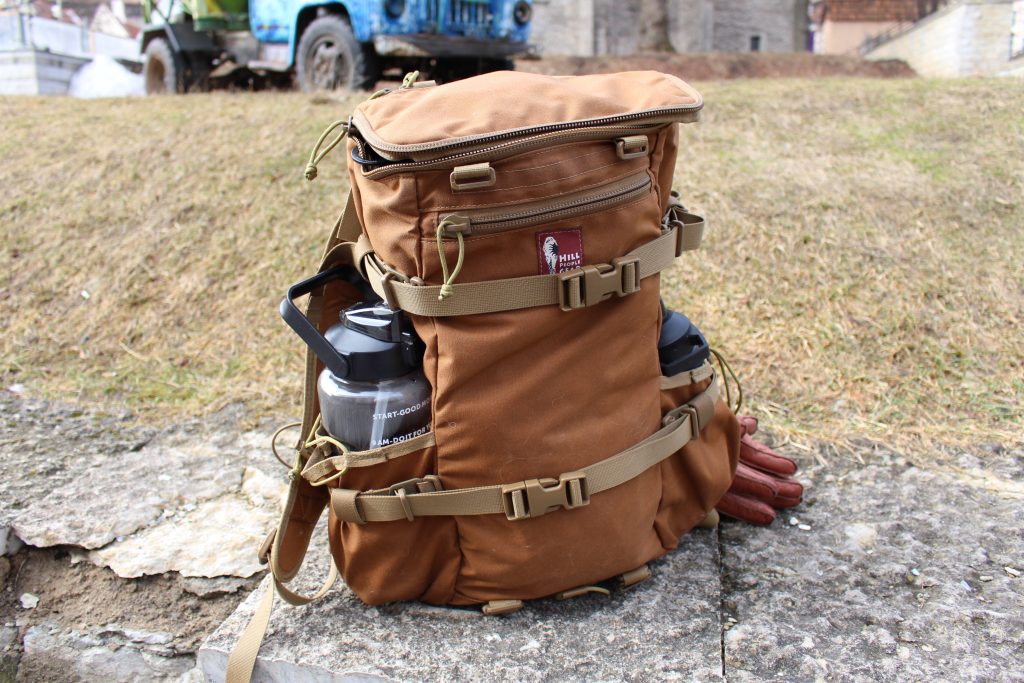We know from experience that among our customers there are the most diverse motivations and motives for keeping a stock of food. We at SicherSatt AG are deliberately politically and denominationally neutral and unbiased with regard to the personal convictions of our customers. We produce and sell long-lasting food of the best quality and thus want to help satisfy our customers’ need for food security.
Escape Backpack Bag Out Bag
23. August 2023

What exactly is an escape backpack (Bug Out Bag)?
-An escape backpack (Bug Out Bag) is a set of equipment that contains everything you need to survive on your own for at least 72 hours. The number 72 comes from the fact that we as humans cannot survive without water for more than 72 hours.
However, an escape backpack doesn’t always have to be designed for exactly 72 hours. Some people need it for 12 hours, while others pack a tent in their bug out bag for a longer stay in the wilderness.
As written in the introduction, the contents of an escape backpack depend on the situation and needs.
The Bug Out Bag is also called “escape backpack” or “survival backpack” in Germany. So, the main purpose is survival on an escape from a disaster or emergency.
Emergencies do not have to be earthquakes, volcanic eruptions, hurricanes, wars, gas crises, blackouts or nuclear bombs immediately. An example: you live in a big city and an aerial bomb from World War II needs to be defused. Then it is very likely that you have to leave your home spontaneously.
An escape backpack filled is recommended by the Federal Office for Civil Protection and Disaster Assistance, and is like an insurance on life and limb, you have it in the hope that you never need it.

The exact makeup may vary depending on individual needs and the potential dangerous situation.
However, here are some important items that are usually included in an escape backpack:
Water and food: portable water filters, water bottles, non-perishable food items (such as energy bars, nuts, canned goods), drinking water bags.
First aid kit: medical bandages, wound disinfectant, pain relievers, personal medications, insect repellent, sunscreen, gloves.
Tools: multipurpose tools, pocket knife, lighter, zip ties, rubber ropes, duct tape, compass, maps, rope.
Clothing and protection: weather protective clothing, warm clothing (such as hat, gloves, thermal underwear), sturdy shoes, rain poncho, valuables bag.
Communication and orientation: cell phone, power bank, radio, flashlight, spare batteries, emergency whistle, signaling device.
Outdoor survival equipment: Tent tarp, sleeping bag, sleeping pad, fire starter, waterproof matches or lighter, camping utensils, drinking cup.
Personal documents: copies of identification, passport, driver’s license, birth certificates, insurance documents, cash in small denominations, important phone numbers and addresses.
It is important to periodically review and adjust the escape backpack based on individual needs. Additionally, emergency plans and other accessories such as sanitary items and hygiene products should be considered.
-An escape backpack (Bug Out Bag) is a set of equipment that contains everything you need to survive on your own for at least 72 hours. The number 72 comes from the fact that we as humans cannot survive without water for more than 72 hours.
However, an escape backpack doesn’t always have to be designed for exactly 72 hours. Some people need it for 12 hours, while others pack a tent in their bug out bag for a longer stay in the wilderness.
As written in the introduction, the contents of an escape backpack depend on the situation and needs.
The Bug Out Bag is also called “escape backpack” or “survival backpack” in Germany. So, the main purpose is survival on an escape from a disaster or emergency.
Emergencies do not have to be earthquakes, volcanic eruptions, hurricanes, wars, gas crises, blackouts or nuclear bombs immediately. An example: you live in a big city and an aerial bomb from World War II needs to be defused. Then it is very likely that you have to leave your home spontaneously.
An escape backpack filled is recommended by the Federal Office for Civil Protection and Disaster Assistance, and is like an insurance on life and limb, you have it in the hope that you never need it.
How useful is a getaway backpack?
The main purpose of an escape backpack is to enable rapid evacuation in the event of a disaster. It is therefore advisable to gather all the goods and equipment needed for this purpose in one place, as in a bag or some storage containers.
If you are not able to escape with a BOV (Bug Out Vehicle), such as an caravan, one should be able to resort to a well-equipped backpack.
Should everyone own an escape backpack?
In general, it is advisable to prepare for emergencies and crises with a bug out bag. An escape backpack is especially helpful if you live in flood zones, earthquakes, hurricanes or other disasters may occur.
– Whether you want to be prepared for medical emergencies while traveling or live in a more stormy weather zone, these backpacks can be essential for survival. However, everyone packs their backpack differently depending on their own needs.
– A good bug out bag will save time when seconds count at crucial moments. When the escape backpack is ready, you can evacuate immediately.
– This way you focus all your time, energy and attention on getting to safety.
We recommend buying a backpack that won’t break your wallet, is sturdy, and ideally fits well on your own body.
-The backpack must be well made. That is, it must not have any weak points when fully packed. Even after years of hiking, or survival training, the backpack must never show defects.
Are prefabricated bug out bags useful?
Pre-made escape backpacks (bug out bags) are not recommended by experts. Almost every company tries to offer a cheap price by cutting corners on the equipment. That is to buy cheap equipment that you can not rely on.
Or the purchased escape backpack has the wrong mix of equipment from the beginning and you have to replace / add a lot of material.
Sure, pre-made escape backpacks are better than nothing, but by and large they are not tailored to individual needs.
Climate should be kept in mind, what works for one may not work for another.
But even a bug out bag for a power outage looks different than one for an earthquake.
Best case scenario, you’ve bought an escape backpack that you’ll never use, but makes us feel safe. In the worst case, you actually rely on it to survive, and you may be seriously injured or even killed.
Our tip: Be sure to put together your own Bug Out Bag.
How heavy should a Bug Out Bag be?
Many people usually put together backpacks that are way too heavy because they assume they are in a vehicle, overestimate their physical fitness, or underestimate how hard it is to carry 25 kg on your back for hours.
You may have to park your vehicle, hike 19 km through the wilderness, climb high stairs, or wade through flood waters.
You or someone in the group might get hurt. And you will probably be tired and hot/cold and hungry.
In general, an adult’s escape pack should not exceed 20% of their body weight.
This rule is important because people tend to pack too much.
Here’s a great rule of thumb:
- If you don’t exercise at least three hours a week, you should stay under 20% of your body weight or under 20 kg – whichever is less.
- If you exercise a lot and are already comfortable hiking with gear, you can carry up to 30% of your body weight or about 27 kg – whichever is less.
- So, for example, if you weigh 80 kg and don’t do any sports, your backpack should never weigh more than 16 kg.
It is important to test your backpack fully packed. Hiking a few kilometers with it, you get a much better feel for the weight.
What belongs in an escape backpack?
It depends on the needs of the individual, so here is a suggestion:
The different levels of an escape backpack:
Escape backpack level 1: Under 10 Kg, for backpacks of about 25 L.
A well-rounded kit that covers the essentials needed to survive. Put together for standard emergencies, like a natural disaster, getting through everyday life for a few days.
Escape backpack level 2: Under 15 Kg, for backpacks of about 44 L.
Now included is a sleeping pad, which is strapped to the outside of the backpack.
In this level, you add essential gear to the essential gear, such as a solar charger and sleeping gear.
Escape backpack level 3: Under 20 kg, Fits in backpacks over 50 L
The sleeping pad is now joined by a tent, which is strapped to the outside. If you want to carry it in your backpack, you need to plan for about 60 liters of capacity.
The 50-liter bug-out bag is ideal to be prepared for all kinds of emergencies, including long-term disasters.
Checklist:

Escape backpack level 1
The 25 liter backpack should not weigh more than 10 kg at level 1.
- First aid kit, level 1
- 1 liter of water in a stainless steel water bottle
- Folding canister / collapsible water bottle
- Water filter
- 30 water purification tablets
- Food, which is immediately edible
- 2x lighter
- Tinder
- Headlamp
- Fixed knife
- Multitool
- 30 meters paracord
- Tarp
- Waterproof notebook and pen
- Documents (USB and paper)
- Money
- Soap
- Toilet paper
- Cap/Hat
- Socks
- Underpants
- Pants
- Top base layer
- Jacket
- Bandana
- Shoes
- solar/crank radio
- USB charging cable and wall plug
- Powerbank
- respirator possibly filter
- Storage bag
- Smartphone
Escape backpack level 2
The 44 liter backpack should not weigh more than 15 kg at level 2. The following is added to level 1:
- First aid kit, level 1 + 2
- Food that requires boiling water
- Stormproof matches
- Portable stove for boiling water
- Cooking vessel
- Spork
- Second flashlight / camping lantern
- Sleeping bag
- Camping mat
- Wet wipes
- Toothbrush and toothpaste
- Lip balm
- Sunglasses
- Binoculars
- Gloves
- Belt
- Map
- Compass
- Solar charger
- Waterproof deck of cards
- Packing straps for tying down tents
Escape backpack level 3
The 50+ liter backpack should not weigh more than 20 kg at level 3. The following is added to level 1 and 2:
- First aid kit, level 1 + 2 + 3
- Fire steel
- Additional batteries
- Battery charger
- Tent
- Hand sanitizer
- Signal mirror / whistle
- Hand saw
- Grinding stone
- Second pair of socks
- Survival manual
CONCLUSION: An emergency backpack must be ready to hand.
In order for the emergency backpack to serve faithfully in crisis preparedness, it is especially important that it is well filled, ready packed and ready to hand.
In an emergency situation everyone is the next, one should be as inconspicuous as possible on the way and no covetousness of other fleeing, arouse!
Who does not provide, has later worries! Who does not realize this, runs the risk to pay in a crisis situation with much more valuable.
